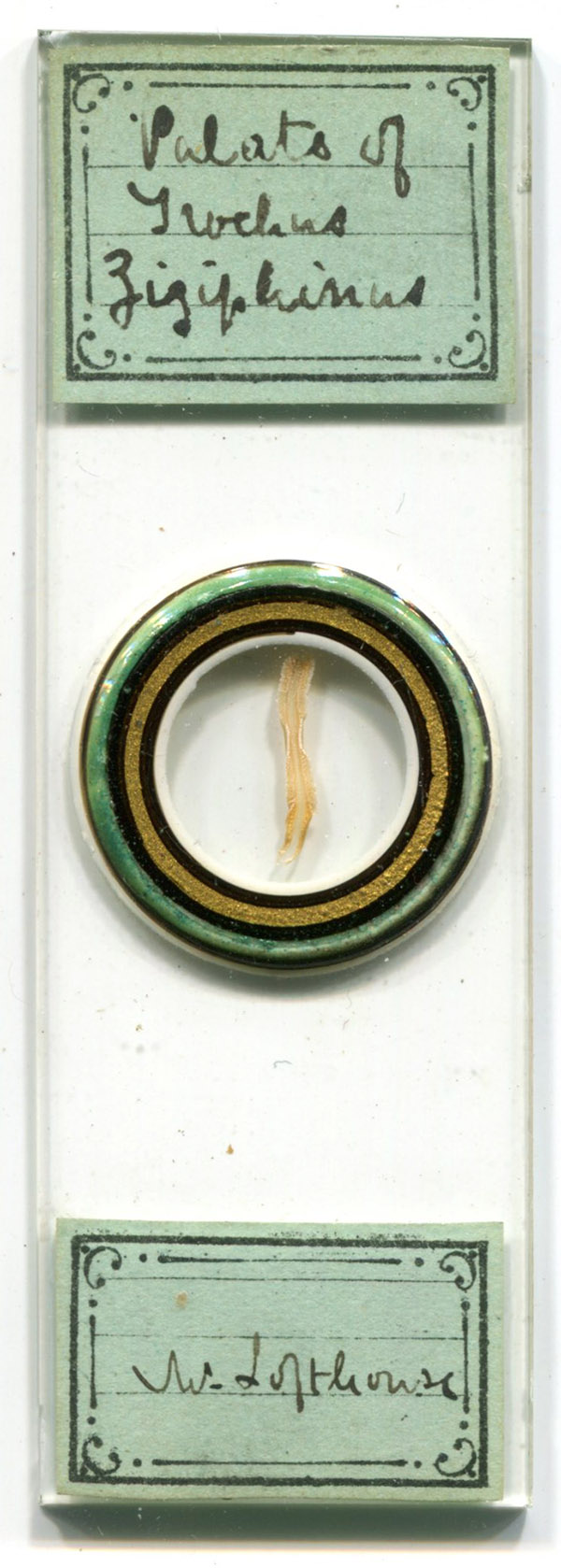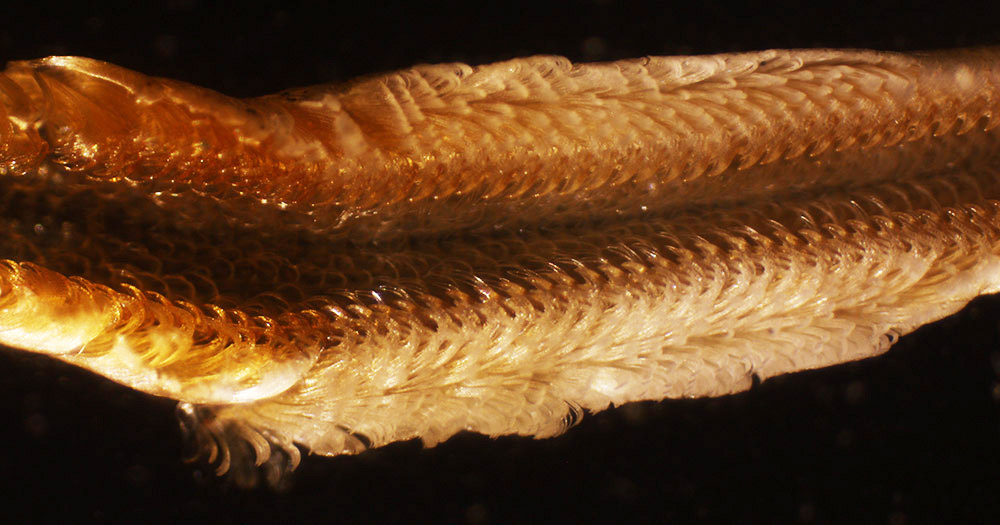Thomas William Lofthouse, 1833 - 1906
by Brian Stevenson
last updated August, 2019
A skilled amateur microscopist, Lofthouse is especially notable for the colorful artistry of his microscope slides (Figure 1). He was a founding member of the Manchester Microscopical Society. Lofthouse is frequently described in minutes of MMS meetings as demonstrating mounting techniques, often preparing slides from start to finish during an evening. Preparing insect mouthparts was a specialty; he published detailed instructions on “mounting the proboscis of a fly” in 1883 (see below).

Figure 1.
A microscope slide that was made by T.W. Lofthouse. Note the artistic ringing, with metallic gold, bright green, white, and black. Lofthouse’s signature is on the lower label. It is likely that many of his slides are in collections but were either not signed or that label was lost.

Figure 2.
Magnified view of Lofthouse’s dry-mount of the palate (radula) from the snail Trochus ziziphinus (now Calliostoma zizyphinum). Photographed with top-lighting, a 3.5x objective lens, and C-mounted digital SLR camera.
Not untypical for Victorians, Thomas Lofthouse’s life had a heavy dose of tragedies.
He was baptized in Manchester on August 10, 1833, and so was likely born a few weeks before that date. He was the second child, and second son, of Thomas and Mary Lofthouse. The father was a painter who died young, in 1848, from “asthma”. He evidently left the family in good financial conditions, however: the 1851 census stated that his widow did not have an occupation, 17 year-old Thomas was “entering college”, and the third child, Mary, was 11 years old and attending school.
Thomas presumably studied accounting in college, and worked for the remainder of his life as a book keeper.
He married Margaret Evans on October 16, 1856, at the Manchester Cathedral. The had five children: two girls, then three boys. The youngest child, George, died in 1868, when only 2 years old. Thomas’ wife, Margaret, passed away in 1874. The 1881 census shows that Thomas’ sister, Mary, had also been widowed, and lived with her two children in the house of Thomas and his children.
Lofthouse’s life was sufficiently comfortable that he could partake in microscopy, a somewhat expensive hobby. To judge from records of his numerous detailed preparations, he undoubtedly owned a decent microscope. He joined the Manchester Microscopical Society on the evening of its founding, as was later recounted by John L.W. Miles, “This meeting was held on the 18th of December, 1879, at the old Mechanics' Institution, Princess Street, and was attended by some twenty-seven gentlemen. Dr. John Tatham was in the chair, and after some little deliberation the Society then and there started on its career. Thirty-three names were enrolled, Dr. Tatham was elected President, and a Provisional Committee was appointed (of which I was one) to draw up rules, &c. Amongst those who attended this meeting were several well known names, viz. : Messrs. E. Ward, Rd. Bastow, R. Graham, Thos. Brittain, W. Chaffers, T.W. Lofthouse, E.P. Quinn, W.W. Dawson and J.H. Furnival; all of whom afterwards did their utmost to make the Society a success”.
Lofthouse regularly displayed his microscope slides at MMS meetings. Notably, at the meeting of October, 1882, “A special feature of the meeting was the illustration of the various processes in connection with the preparation and mounting of objects. This was practically shown at the various tables by Messrs. Lofthouse, Miles, Furnival, Stanley, Hay, Graham, Chaffers, and Hall. These gentlemen successively showed the mounting of an object, from the centering of the slide and making the cell to the embedding of the object in its medium and finishing it off with its plain or ornamental ring of coloured varnish”.
The MMS actively encouraged its members to become proficient at making their own slides. A report of an 1882 meeting of the Mounting Class stated, “At another table sat Mr. T.W. Lofthouse, who essayed to shew the process of mounting the proboscis of blow-fly in balsam. This is an old and familiar object. Few microscopists but what are acquainted with the mount; fewer still, strange to say, know how, or can put the mount together. Simple indeed appeared the operation as performed by Mr. Lofthouse with entire success. Matters were simplified much by a number of ingenious clips, springs, and other apparatus invented by the demonstrator, and which could be easily made by the lookers on. Whether those who watched the proceedings will find the execution of work as simple and easy a matter as it looked when done by skilled hands remains to be seen”.
His method for preparing fly mouthparts was published in the January, 1883, issue of The Microscopical News and Northern Microscopist:
“Mounting the Proboscis of a Fly, by T.W. Lofthouse.
Kill the fly by putting it into a bottle containing a little carbolic acid that has been rendered fluid by the addition of a drop or two of water, - no more water should be used than is necessary. Acid, so prepared, may be obtained from Mr. Ward. Cut off the head, and place it in a small porcelain saucer and cover with a little of the acid, which must be changed about every other day for say a week, or until it ceases to become coloured. The tongue will then, in most cases, be found to be protruded, or may be forced out by slightly pressing the head.
Expanding. - To expand the tongue, it should be placed in the centre of a glass slip, and put upon a piece of wood, about 5 inches long by 1 1/4 inch wide, into one end of which a piece of wire has been inserted and bent over to form a clip, the centre being covered with a circle of white paper to form a light background. A piece of glass about 1 inch by 1 1/2 inches, to be used as a presser, is placed upon the glass and under the spring, and is kept apart from the slip by several folds of paper about the thickness altogether of the fly's head. The head, with the eyes uppermost, and the tongue protruded towards the right hand, is then placed in a drop of acid under the edge of the presser and held there, and, if necessary, the tongue forced to protrude further by a slight pressure of the forefinger of the left hand. While in this position the expander, a piece of glass 1 inch long and 3/4 of an inch wide, to the under side of which a small covering glass has been fastened by brown cement, and having a piece of paper by which to hold it gummed to the top (Figure 3 of this essay), is used to force the lobes of the tongue backwards, that is towards the left hand, and downwards into the required position. The Palpi, which will usually be found lying against the head, may then be arranged by means of a stiff bristle, and the head laid aside for three or four days to set .
Mounting. - After cutting away the head, transfer the tongue which must be kept the same side up, to a drop of fresh acid on the centre of a clean glass slip. This may be done by pushing it on to the end of a quill which has been bent a little at the end, to form a kind of a spoon. Apply balsam at the right-hand side of the cover-glass, and drain off the acid by holding a piece of blotting paper to the opposite edge. If any cloudiness appears, warm the slide a little. A light slip may then be put on, and the slide put aside to harden. No needles should be used in any part of the process”.

Figure 3.
Illustration that accompanied Lofthouse’s 1883 article on mounting the proboscis of a fly.
Minutes of the October, 1883, meeting of the MMS included, “Some interesting processes of a popular nature will be shown to you to-night by some of the members of the section. … Mr. Lofthouse will extract and mount the tongue of the bee”.
Thomas Lofthouse was elected to be a Vice-President of the MMS in 1886.
The recollection of MMS history by John Miles that was quoted above was presented to the Society in 1905. The phasing implies that Lofthouse was still an active participant in Society events.
Lofthouse died shortly afterward, on January 18, 1906.
That year’s MMS Annual Report included, “Amongst those who have passed away during the year mention must be made of Mr. Thomas William Lofthouse, one of the original members, to whom the Society is indebted for the useful work he performed in the early days of its existence”.
Resources
Baptism record of Thomas William Lofthouse (1833) Records of Manchester Parish, accessed through ancestry.com
Death record of Thomas Lofthouse (1844) Records of the Wesleyan Methodist Church, Irwell Street, Salford, Lancashire, accessed through ancestry.com
England census and other records, accessed through ancestry.com
Lofthouse, T.W. (1883) Mounting the proboscis of a fly, The Northern Microscopist and Microscopical News, Vol. 3, pages 21-22
Manchester Microscopical Society Annual Report and Transactions (1886) Members: “Lofthouse T.W., 39 Stockton-street, Moss Side”, page 30
Manchester Microscopical Society Annual Report and Transactions (1906) page 8
Marriage record of Thomas William Lofthouse and Margaret Evans (1856) Records of Manchester Cathedral, accessed through ancestry.com
Miles, J.L.W. (1905) The inception and formation of the Manchester Microscopical Society, Manchester Microscopical Society Annual Report and Transactions, pages 39-40
The Naturalist (1886) Report of annual meeting of the Manchester Microscopical Society, page 159
The Northern Microscopist and Microscopical News (1882) Reports of meetings of the Manchester Microscopical Society, Vol. 2, pages 99, 318-319, and 354
The Northern Microscopist and Microscopical News (1883) Reports of meetings of the Manchester Microscopical Society, Vol. 3, pages 239, and 299-304
Probate of the will of Thomas W. Lofthouse (1906) “Lofthouse Thomas William of 26 Yarburgh-street Moss Side Manchester died 18 January 1906 Probate London 14 March to Thomas William Lofthouse artist and Frank Lofthouse commercial-clerk Effects £3080 16s 1d”, accessed through ancestry.com


